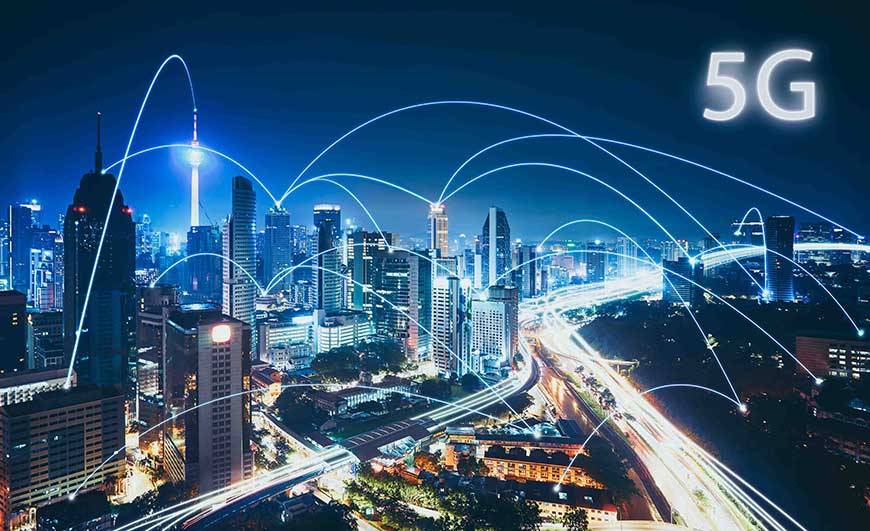Delivering 5G network speed of up to 100 Gigabit/sec by 2022

As the dawn of 5G approaches, 1.2 billion people stand to be connected, with access to potential speeds of 100 Gigabit/sec. Compared to previous mobile network speeds such as 4G, recorded as performing up to 300Mb/s when optimal, 5G’s advances mark a phenomenal leap forward in the realm of data exchange and bandwidth – a whole 100 times faster! You’ll be able to download a HD movie in 10 seconds, think about that for context. The Fifth Generation Mobile Network (5G) will enable greater capacity and open a whole new set of use cases as networks will be able to cope with high-demand applications simultaneously. Autonomous cars will benefit particularly from 5G’s high-speed and low-latency response of 1m/s, improving the technology’s reaction time for a safer experience. It takes 300-400m/s to blink, so blink and you will certainly miss it, as the response time will be physically undetectable by the user. The adoption of 5G will have widespread effects on everything from the IoT (Internet of Things) and the emergence of smart cities, to virtual-augmented reality, edge computing and BIG Data, remote-robotic surgery and health services, and even holographic video, among many more. The technology will provide improved functionality and nearer to “real-time” capability as well as potentially enabling some technology to move from concept to reality. As technology develops in order to function with 5G you will certainly need to upgrade your phone in 2022 if you want to access the future of communication.
Economic Benefits
The advance is also predicted to have considerable economic benefits according to O2’s report stating that the UK could benefit from time and productivity savings of £6 billion pa. The report finds that householders could also save £450 a year from the benefits and capabilities of 5G-enabled devices and systems such as smart grids, electric autonomous vehicles and smart homes.
The UK is set to launch with 5G in 2020, aiming to be widespread by 2022, whereas other countries such as Japan and China are expecting to launch 5G later this year (2018). The estimated global investment for the required 5G infrastructure is predicted to be $326B by 2025. Some of the major companies involved in the development of 5G include: Ofcom, Qualcomm, Deutsche Telekom, Ericsson, Huawei, Intel, NextVR, Nokia, SK Telecom and Samsung.
What about Fibre Optic?
As mobile networks get faster, and highly-dependable wireless connectivity becomes more widespread, what does that mean for Fibre Optic and other wired internet facilities?
An article from Ciena states - “5G's formidable network performance goals are heavily predicated on the availability of fiber, and lots of it, to cell sites.”
As 5G.co.uk explains, “5G will use new, higher radio frequencies because they are less cluttered, and they carry information much faster.” Although higher frequency bands carry data faster they won’t be able to carry it as far, which will mean the implementation of a network of smaller cell towers to boost the signal and carry further, bringing it closer to users.
Over recent years, Mobile Network Operators have increasingly favoured this adoption of “small network cells”, which are strategically linked down from a core network to smaller subnetworks and placed closer to customers, as it generally improves coverage, capacity and overall experience quality for the users.
Small cells are traditionally backhauled (linked) back to the core network using copper, air (microwave, millimetre wave) or Fibre Optic. All three variants function with varying performance characteristics and are chosen for installation based on factors such as economy, environmental, regulatory, and application.
However, Fibre Optic has always been the cable of choice in these installations providing it’s viable, as the technology is generally more cost-effective, offers the fastest speeds, scalability, security and it’s also widely understood.
The need for smaller network cells will increase with the proliferation of 5G, bringing with it the continued high-demand for Fibre Optic cable as the preferred solution for connection to the core network.
As a recognised supplier of Fibre Optic Cable Eland Cables greets the upcoming advances of 5G equipped with industry leading complete cable solutions, supplying products conforming to internationally recognised standards and project services from concept to completion. We’re ready for the future. See our full Fibre Optic Cable range at www.elandcables.com/cables/fibre-optic-cables.